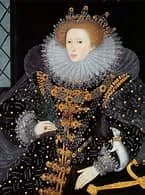From Queens to Coco
Queen Elizabeth I
Throughout History, Fashion has been used to evoke a persona, to make a social statement, or simply to imbue ourselves with self confidence.
Queen Elizabeth I wore excessive amounts of makeup to cover the scars she’d received from a childhood bout of smallpox. She not only beat back an armada, she fashioned herself into a larger-than-life figure (literally!) through the use of fabric, corsetry, and those fantastical “ruffs” around the neck - the original power shoulders, you might say. Her use of makeup and clothing were purposefully designed to reflect her desired persona of a strong and powerful Queen.
Let’s jump ahead to the 20th Century. Feeling constrained by the morality-driven styles of the Victorian era, Coco Chanel famously freed women from corsetry and created a more relaxed silhouette that allowed for greater freedom of movement, and was purposefully masculine - the beginning of gender-fluid dressing. This came to be known as “la garconne” look, which in French is a combination of the feminine pronoun with the masculine noun for “boy.” The very name explains exactly what Chanel was aiming for as she broke with conventional gender tropes.
When the “Great War” resumed in the 1940’s, fabric and other niceties such as stockings were in short supply, resulting in the relatively drab look that identifies the period - although we do begin to see suiting and even strong shoulders for women, as they entered the workforce en mass. This look would be emulated again later in the 1980’s as women once again pursued careers with more vehemence than ever before, thanks to a burgeoning women’s movement that (arguably) began in the 70’s.
Then came (sigh of relief!) the end of the War and with it, a new sense of celebration and sartorial joy! Dior with his bar suit and his “new look,” while relegating women back to corsets to achieve that idealized “hourglass figure,” was also revolutionary. Highly controversial at the time, the pleating of the skirt required what some considered to be an excessive use of fabric, given the rationing during wartime. The bar suit evolved into the cocktail dresses of the 1950’s with tulle and voluminous skirts adorned with jewels and paired back to long gloves and high heels. (Personally, my favorite era in fashion! I always did love the dress worn by Vera Ellen in “White Christmas,” as an example….so maybe I was a fashionista early on.)
The 60’s (Andre Courrages’ “moon girl” collection, featuring space-age looks and the first A-line dresses) the 70’s (Halston’s fluid, figure skimming dresses and pantsuits ideal for dancing the night away at Studio 54) and the 80’s (Alaia’s bodycon looks and the power suiting mentioned earlier) were undoubtedly also high water marks in the history of fashion.
I enjoy learning about the history of designers and fashion because it helps me put everything into context. There’s nothing I see today that doesn’t remind me of a bygone era. Slouchy, gender-fluid pant suits at Louis Vuitton? Think 1940’s power shoulders, 1990’s grunge, or Coco’s la garconne look - everything that goes around comes around.
